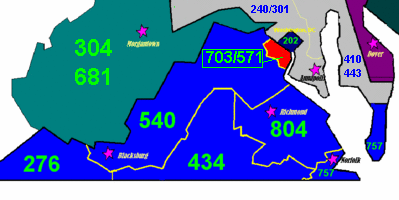Area codes 571 and 703

Area codes 703 and 571 are the North American Numbering Plan telephone area codes for northern Virginia, including the independent cities of Alexandria, Fairfax, Falls Church, Manassas, and Manassas Park, as well as all of Arlington and Fairfax counties and parts of Fauquier, Loudoun, Prince William, and Stafford counties. The main area code, 703, was created as one of the original 86 North American area codes in October 1947, and originally served the entire Commonwealth of Virginia. Area code 571 was created on March 1, 2000 as an overlay to 703.
Dialing requirements
Because of the overlay of 703 and 571, 10-digit dialing is mandatory even for local calls; cellphone callers do the same on all direct-dialled calls. Long-distance calls are dialed as eleven digits, using the prefix 1, but for landline-based phones only.[1]
Service areas
Area code 703 and the overlay area code 571 serve the following cities and towns in Virginia: Alexandria, Annandale, Ashburn, Burke, Centreville, Chantilly, Dale City, Fairfax, Falls Church, Franconia, Great Falls, Groveton, Herndon, Lake Ridge, Leesburg, Lorton, Manassas, Manassas Park, McLean, Mount Vernon, North Springfield, Oakton, Occoquan, Reston, South Riding, Springfield, Sterling, Vienna, West Springfield, and Woodbridge, plus all or part of these counties: Arlington, Fairfax, Loudoun, Prince William and Stafford.
History
On June 24, 1973, area code 703 underwent its first split, when the eastern portion of the state became area code 804. Permissive dialing of 703 continued across the Commonwealth until January 1, 1974.[2] 703 was restricted to the northern and western regions of Virginia—from Arlington in the north to the Tennessee and Kentucky border—while everything from Danville eastward was reassigned to 804.
From 1947 to 1990, it was possible for telephone users in the northern Virginia portion of 703 to dial any number in the Washington metropolitan area with only seven digits. While the Washington metro area is split between three area codes–Maryland's 301, the District's 202, and 703–it was a single local calling area. Every number in the Maryland and Virginia portions of the metro area was protected from assignment in the District's 202, essentially making 202 an overlay for the entire metro. One consequence of this was that no central office prefix could be duplicated anywhere in the Washington metro area. For instance, if a 1-202-574 number was in use in the District or a 1-301-574 was in use on the Maryland side of the metro, the corresponding 1-703-574 number could only be used in areas considered a safe distance from the Washington metro area, such as Roanoke and the Tri-Cities. By the end of the 1980s, the D. C. area was running out of numbers, so the partial overlay of 202 was ended in 1990.
However, it soon became apparent that breaking seven-digit dialing in the Washington area would not free up enough numbers to keep up with demand on either side of the Potomac River. The number shortage was exacerbated by the fact that most of the Washington metro area is a single LATA, meaning that many numbers in both the District and in Maryland were not available for use. With this in mind, on June 19, 1995, most of the western portion of the old 703 area code was split off into the new area code 540, and 703 was restricted to northern Virginia. The same issue had forced the split of area code 410 from 301 four years earlier.
The 1995 split was intended to be a long-term solution. However, within four years, 703 was close to exhaustion due to the proliferation of cell phones, fax machines, and pagers, as well as northern Virginia's explosive growth. To solve this problem, area code 571 was introduced on March 1, 2000, as an overlay to 703. Area code 571 serves most new telephone numbers; while it is primarily associated with mobile telephone lines, it is also used for new landline numbers, including the United States Patent and Trademark Office upon moving to Alexandria; the Transportation Security Administration, which was created in 2001 and has its headquarters in Arlington; and the Fairfax County Public Schools, which moved its headquarters to the Falls Church area in 2006.
Local service providers
Although former competitors Bell Atlantic (a former Baby Bell) and GTE had assigned geographical monopolies varying by region in Virginia, they merged in the late 1990s to form Verizon, now the dominant local telephone service provider throughout Virginia, including both of these area codes. Over 85% of all telephone numbers in both of these area codes are served by Verizon, a regulated monopoly.
However, mobile telephone service is provided with numbers assigned these area codes by various operators such as Sprint, AT&T, and T-Mobile, in addition to Verizon Wireless.
Competition in the local telephone service market within these area codes has been joined by cable television operators such as Cox Communications, Comcast, and Verizon FiOS, which provide local telephone service running over their own broadband fiber optic telecommunication networks (which also provide cable television and high-speed internet services).
See also
References
External links
- NANPA Area Code Map of Virginia
- List of exchanges from AreaCodeDownload.com, 571 Area Code
- List of exchanges from AreaCodeDownload.com, 703 Area Code
- Phone prefixes in the 571 Area Code - National Phone Number Registry
- Phone prefixes in the 703 Area Code - National Phone Number Registry
- 703 Area Code | Counties | Cities
- List of exchanges from PhoneLookupMate.com, 571 Area Code
- List of exchanges from PhoneLookupMate.com, 703 Area Code
| Virginia area codes: 276, 434, 540, 571/703, 757, 804 | ||
|---|---|---|
| North: 301/240 | ||
| West: 540 | area code 703/571 | East: 301/240, 202 |
| South: 540 | ||
| District of Columbia area codes: 202 | ||
| Maryland area codes: 240/301, 410/443/667 | ||